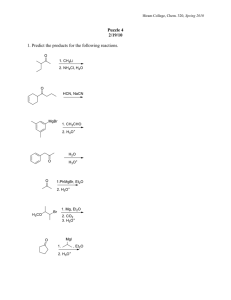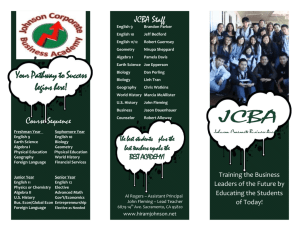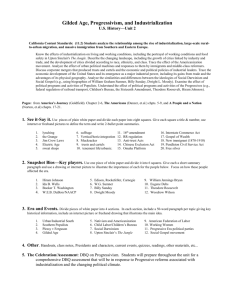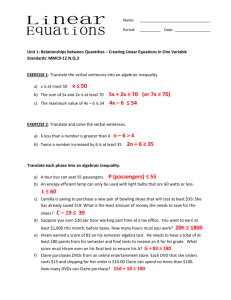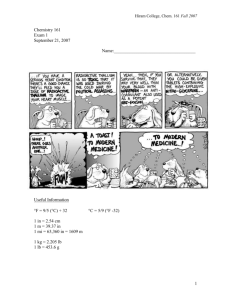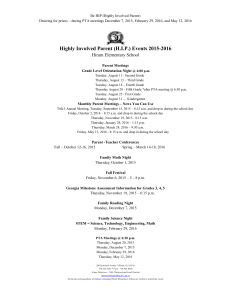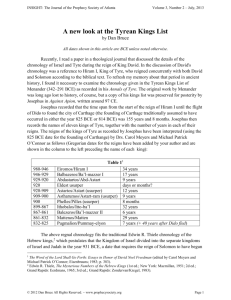Incentive Plan s
advertisement
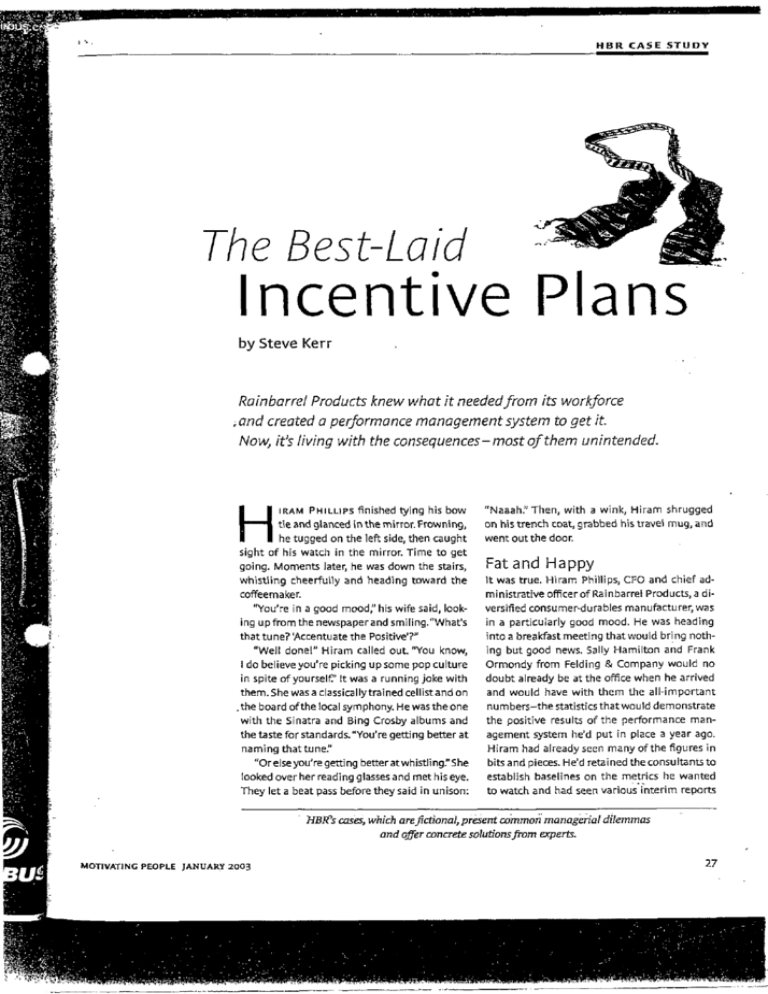
The Best-Lai d Incentive Plan s by Steve Ker r Rainbarre/ Products knew what it needed from its workforc e and created a performance management system to get it . Now, it's living with the consequences—most of them unintended. TRAM PHILLIPS finished tying his bow tie and glanced in the mirror . Frowning , he tugged on the left side, then caugh t sight of his watch in the mirror. Time to get going . Moments later, he was down the stairs, whistling cheerfully and heading toward th e coffeemaker. "You're in a good mood ;' his wife said, looking up from the newspaper and smiling ."What's that tune? 'Accentuate the Positive'?" "Well done!" Hiram called out . "You know, I do believe you're picking up some pop cultur e in spite of yourself.' It was a running joke with them .She was a classically trained cellist and o n . the board of the local sym phony . He was the on e with the Sinatra and Bing Crosby albums an d the taste for standards . "You're getting better at H naming that tune." "Or else you're getting better at whistli ng!' She looked over her reading glasses and met his eye . They let a beat pass before they said in unison : "Naaah7 Then, with a wink, Hiram shrugge d on his trench coat, grabbed his travel mug, an d went out the door. Fat and Happy It was true . Hiram Phillips, GO and chief administrative officer of Rai nbarrel Products, a di versified consumer-durables manufacturer, wa s in a particularly good mood . He was headin g into a breakfast meeting that would bring nothing but good news . Sally Hamilton and Fran k Ormondy from Felding & Company would n o doubt already be at the office when he arrive d and would have with them the all-importan t numbers–the statistics that would demonstrat e the positive results of the performance management system he'd put in place a year ago . Hiram had already seen many of the figures i n bits and pieces . He'd retained the consultants t o establish baselines on the metrics he wante d to watch and had seen various interim reports are fictional, presentcommon managerial dilemma s and offer concrete solutions from experts. HBR's cases, which MOTIVATING PEOPLE JANUARY 2003 HBR CASE STUDY from them since . But today's meeting would b e the impressive summation capping offa year' s worth of effort. Merging into the congestion o f Route 45, he thought about the upbeat presentation he would spend the rest of the mornin g preparing for tomorrow's meeting of the corporate executive council . It was obvious enough what his introductio n should be. He would start at the beginning–or , anyway, his own beginning at Rainbarrel Prod ucts a year ago . At the time, the company had just come off a couple of awful quarters . I t wasn't alone . The sudden slowdown in consumer spending, after a decade-long boom, ha d taken the whole industry by surprise . But what had quickly become clear was that Rainbarre l was adjusting to the new reality far less rapidl y than its biggest competitors. Keith Randall, CEO of Rainbarrel, was know n for being an inspiring leader who focused o n innovation . Even outside the industry, he ha d a name as a marketing visionary . But over th e course of the ten-year economic boom, he ha d allowed his organization to become a little lax . Take corporate budgeting . Hiram still smile d when he recalled his first day of interviews wit h Rainbarrel's executives . It immediately becam e obvious that the place had no budget integrit y whatsoever. One unit head had said outright , "Look, none of us fights very hard at budge t time, because after three or four months, nobody looks at the budget anyway!' Barely concealing his shock, Hiram asked how that coul d be; what did they look at, then? The answer wa s that they operated according to one simple rule : "If it's a good idea, we say yes to it. If it's a ba d idea, we say no." "And what happens," Hiram had pressed , "when you run out of money halfway throug h the year?"The fellow rubbed his chin and too k a moment to think before answering . "I gues s we've always run out of good ideas before we'v e run out of money:" Unbelievable ! "Fat and happy" was how Hiram characterized Rainbarrel in a conversation with the head hunter who had recruited him . Of course, h e wouldn't use those words in the CEC meeting . That would sound too disparaging . I n fact, he' d quickly fallen in love with Rainbarrel and the opportunities it presented . Here was a compan y that had the potential for greatness but that wa s held back by a lack of discipline . It was like a racehorse that had the potential to be a Secre tariat but lacked a structured training regimen . Or a Ferrari engine that needed the touch of a n expert mechanic to get it back in trim . In othe r words, the only thing Rainbarrel was missin g was what someone like Hiram Phillips coul d bring to the table. The allure was irresistible ; this was the assignment that would define hi s career. And now, t year later, he was ready to declare a turnaround . Lean and Mea n Sure enough, as Hiram steered toward the entrance to the parking garage, he saw Sally an d Frank in a visitor parking space, pulling thei r bulky file bags out of the trunk of Sally's sedan . He caught up to them at the security checkpoint Steve Kerr is the chief learning officer at Goldman Sachs in New York. Prior to joining Goldman Sach s in toot, he spent seven years as the chief learning officer and head of leadership development at GE. H e was responsible for GE's leadership development center at Crotonville. HARVARD BUSINESS REVIEW in the lobby and took a heavy satchel fro m Sally's hand . Moments later, they were at a conference table, each of them poring over a copy of th e consultants'spiral-bound report ."This is great; ' Hiram said . " I can hand this out just as it is, Bu t what I want to do while you're here is to reall y nail down what the highlights are . I have th e floor for qo minutes, but I guess I'd better leav e ten for questions . There' s no way I can plow through all of this ." "If I were you ;' Sally advised,"I would lead of f with the best numbers. I mean, none of them are bad . You hit practically every target . But some of these, where you even exceeded th e stretch goal . . . " Hiram glanced at the line Sally was underscoring with her fingernail . It was an impressive achievement : a reduction in labor costs. Thi s had been one of the first moves he'd made, an d . he'd tried to do it gently. He came up with the idea of identifying the bottom quartile of performers throughout the company and offerin g them fairly generous buyout packages . Bu t MOTIVATING PEOPLE JANUARY 2003 when that hadn't attracted enough takers, he' d gone the surer route . He imposed an acrossthe-board headcount reduction of 10% on all th e units . In that round, the affected people wer e given no financial assistance beyond the normal severance . " It made a big difference ;' he nodded . " Bu t it wasn't exactly the world's most popular move :' Hiram was well aware that a certain segmen t of the Rainbarrel workforce currently referre d to him as "Fire 'em ." He pointed to anothe r number on the spreadsheet Now, that one tell s a happier story: lower costs as a result of higher productivity? ' "And better customer service to boot," Fran k chimed in . They were talking about the transformation of Rainbarrel's call center—wher e phone representatives took orders and handle d questions and complaints from both trade an d retail customers . The spreadsheet indicated a dramatic uptick in productivity: The number of calls each service rep was handling per day had gone up 5o% . A year earlier, reps were spending up to six minutes per call, whereas now the HBR CASE STUDY average was less than four minutes ."' guess yo u decided to go for that new automated switchin g systems Frank asked . "No!" Hiram answered ."That's the beauty o f it . We got that improvement without any capital investment You know what we did? We just announced the new targets, let everyone kno w we were going to monitor them, and put th e As much as Rainbarrel liked to emphasiz e customer service in its values and missio n statement, no reliable metric had bee n in place to track i t names of the worst offenders on a great bi g 'wall of shame' right outside the cafeteria . Neve r underestimate the power of peer pressure! " Sally, meanwhile, was already circling another banner achievement : an increase in on time shipments . "You should talk about this , given that it's something that wasn't even bein g watched before you came!' It was true . As much as Rainbarrel liked t o emphasize customer service in its values an d mission statement, no reliable metric had bee n in place to track it . And getting a metric in place hadn't been as straightforward as it migh t seem–people haggled about what constitute d "on time" and even what constituted "shipped " Finally, Hiram had put his foot down and insisted on the most objective of measures . O n time meant when the goods were promised to ship. And nothing was counted as shipped till i t left company property. Period ."And once again ; ' Hiram announced, "not a dollar of capital expenditure . I simply let people know that, fro m now on, if they made commitments and didn' t keep them, we'd have their number!" "Seems to have done the trick," Sally observed ."The percentage of goods shipped b y promise date has gone up steadily for the last six months . It's now at 92% ." Scanning the report, Hiram noticed anothe r huge percentage gain, but he couldn't recal l what the acronym stood for. "What's this? Look s like a good one : a 50% cost reduction?" The incredibly responsive Aciira R SRI, Precision . Grace . And a 3 .5-liter engine that provides immediate torque a t the tap of your foot . A double-wishbone suspension that delivers precise handling at the flick of your wrist. And to soothe , 3 Sally studied the item . "Oh, that . It's pretty small change, actually. Remember we separated out the commissions on sales to employees?" I t came back to Hiram immediately . Rainbarrel had a policy that allowed current and retired employees to buy products at a substantial discount . But the salespeople who served them earne d commissions based on the full retail value, no t the actual price paid . So, in effect, employee purchases were jacking up the commission expenses . Hiram had created a new policy in whic h the commission reflected the actual purchas e . price . On its own, the change didn't amount t o a lot, but it reminded Hiram of a larger point h e wanted to make in his presentation : the importance of straightforward rules–and rewards–i n driving superior performance . "I know you guys don't have impact data fo r me, but I'm definitely going to talk about th e changes to commission structure and sales incentives. There's no question they must be mak ing a difference " "Right," Sally nodded . "A classic case of'kee p it simple : isn't it?" She turned to Frank to ex- plain ."The old way they calculated commission s was by using this really complicated formula that factored in, I can't remember, at least fiv e different things." "Including sales, I hope?" Frank smirked . "I'm still not sure!" Hiram answered ."No, seriously, sales were the most important singl e variable, but they also mixed in all kinds of targets around mentoring, prospecting new clients , even keeping the account information current . It was all way too subjective, and salespeopl e were getting very mixed signals . 1 just clarifie d the message so they don't have to wonder wha t they're getting paid for. Same with the sale s contests . It's simple now: If you sell the most product in a given quarter, you win : ' With Sally and Frank nodding enthusiastically, Hiram again looked down at the report . Row after row of numbers attested to Rainbarrel's improved performance . It wouldn't be easy to choose the rest of the highlights, but what a problem to have! He invited the consultants to weigh in again and leaned back to bask in th e superlatives . And his smile grew wider. Your soul, there ' s a leather-trimmed interior with an Acura/Bose°'Music System with 6-disc CD changer, and availabl e OnStar . service . For even more information, swing over to a cura .co m or call I-BOO-TO-Acura . ®tCU(R.A HER CASE STUDY Cause for Concer n The next morning, a well-rested Hiram Phillip s strode into the building,flashed his ID badge a t Charlie, the guard, and joined the throng in th e lobby. In the crowd waiting for the elevator, h e recognized two young women from Rainbarrel, lattes in hand and headphones around thei r necks . One was grimacing melodramatically a s she turned to her friend ."I'm so dreading getting to my desk," she said . "Right when I wa s leaving last night, an e-mail showed up from th e buyer at Sullivan . I just know it's going to b e "I can't figure out how you fellas define `shipped' W e were told last Tuesday an order had been shipped, an d come to find out, the stuff was sitting on a railroa d siding across the street from your plant " some big, hairy problem to sort out . I couldn't bring myself to open it, with the day I'd had . Bu t I'm going to be sweating it today trying to respond by five o'clock. I can't rack up any more late responses, or my bonus is seriously history ." Her friend had slung her backpack onto th e floor and was rooting through it, barely listening . But she glanced up to set her friend straigh t in the most casual way."No, see, all they chec k is whether you responded to an e-mail within 2 4 hours of opening it. So that's the key. just don't open it. You know, till you've got time to dea l with it." Then a belltone announced the arrival ofth e elevator, and they were gone. More Cause for Concern An hour later, Keith Randall was calling to orde r the quarterly meeting of the corporate executive council . First, he said, the group would hea r the results of the annual employee survey, cour tesy of human resources VP Lew Hart. Next would come a demonstration by the chief mar keting officer of a practice the CEO hoped to incorporate into all future meetings . It was a "quick market intelligence ;' or QMI, scan, engaging a few of Rainbarrel's valued customers in a prearranged—but not predigested—confer ence call, to collect raw data on customer ser vice concerns and ideas."And finally;' Keith concluded, "Hiram's going to give us some ver y good news about cost reductions and operatin g 32 efficiencies,all due to the changes he's designe d and implemented this past year." Hiram nodded to acknowledge the compliment . He heard little of the next ten minutes ' proceedings, thinking instead about how h e should phrase certain points for maximum effect. Lew Hart had lost him in the first moment s of his presentation on the "people survey" by beginning with an overview of"purpose, methodology, and historical trends ." Deadly. It was the phrase "mindlessly countin g patents" that finally turned Hiram's attentio n back to his colleague . Lew, it seemed, was no w intothe"findings"section of his remarks . Hira m pieced together that he was reporting on an un precedented level of negativity in the response s from Rainbarrel's R&D department and wa s quoting the complaints people had scribbled o n their surveys . "Another one put it this way," Le w said . "We're now highly focused on who's getting the most patents, who's getting the mos t copyrights, who's submitting the most gran t proposals, etc. But are we more creative? It's no t that simple?' "You know," Rainbarrel's chief counsel noted , "I have thought lately that we're filing for a lo t of patents for products that will never be commercially viable:" "But the thing that's really got these guy s frustrated seems to be their 'Innovation X ' project;" Lew continued . "The y' re all saying it' s the best thing since sliced bread,a generationa l leap on the product line, but they're getting n o uptake." Eyes in the room turned to the products divi sion president, who promptly threw up hi s hands ."Whatcan I say, gang? We never expected that breakthrough to happen in this fiscal year. It's not in the budget to bring it to market." Lew Hart silenced the rising voices, reminding the group he had more findings to share . Unfortunately, it didn't get much better. Bot h current and retired employees were complaining about being treated poorly by sales person nel when they sought to place orders or obtai n information about company products . There was a .lotof residual unhappiness aboutthe layoffs, and not simply because those who remained had more work to do . Some people ha d noted that, because the reduction was based o n headcount, not costs, managers had tended to fire low-level people, crippling the compan y without saving much money . And because th e HARVARD BUSINESS REVIEW The Best-Laid Incentive Plan s reduction was across the board, the highest per forming departments had been forced to lay of f some of the company's best employees . Others had heard about inequities in the severanc e deals: "As far as I can tell, we gave our lowest performers a better package than our goo d ones," he quoted one employee as saying . And then there was a chorus of complaints from the sales organization . "No role models!' "No mentoring .""No chance to pick the veterans' brains.""No knowledge sharing about accountsP More than ever, salespeople were dis satisfied with their territories and clamoring fo r the more affluent, high-volume districts ."It didn' t help that all the sales-contest winners this yea r were from places like Scarsdale, Shaker Heights, and Beverly Hills," a salesperson was quoted a s saying . Lew concluded with a promise to loo k further into the apparent decline in morale to determine whether it was an aberration . "That's an important order for us ;' anothe r Brenton voice piped up ."I sent an e-mail to try to sort it out, but I haven't heard back about it ." Hiram winced, recalling the conversation in th e lobby that morning . The voice persisted : " I thought that might be the better way to contac t your service people these days? They alway s seem in such an all-fired hurry to get off th e phone when I call . Sometimes it takes two o r three calls to get something squared away ." The call didn't end there–a few more shortcomings were discussed . Then Keith Randall,to his credit, pulled the conversation onto mor e positive ground by reaffirming the great regar d Rainbarrel had for Brenton Brothers and th e The Ugly Trut h agenda item . But if the group thought the mood would improve in the meeting's next segment–the QM I chat with the folks at longtime customer Brenton Brothers–they soon found out otherwise . Booming out of the speakerphone in the middl e of the table came the Southern-tinged voices o f Billy Brenton and three of his employees repre senting various parts of his organization . "What's up with your shipping department? " Billy called out . "My people are telling me it's taking forever to get the stock replenished :' Hiram sat up straight, then leaned towar d the speakerphone . "Excuse me, Mr. Brenton . This is Hiram Phillips–I don't believe we've met. But are you saying we are not shipping by ou r promise date?" A cough –or was it a guffaw? –came bac k across the wire ."W el I, son . Let me tell you about that . First of all, what y'all promise is not alway s what we are saying we require–and what we believe we deserve . Annie, isn't that right?" "Yes, Mr. Brenton," said the buyer."In some cases, I've been told to take a late date or otherwise forgo the purchase . That becomes th e promise date, I guess, but it's not the date I asked for." "And second," Billy continued,"I can't figure out how you fellas define 'shipped! We were tol d last Tuesday an order had been shipped, an d come to find out, the stuff was sifting on a railroad siding across the street from your plant" MOTIVATING PEOPLE JANUARY 2003 mutual value of that enduring relationship . Promises were made and hearty thanks extended for the frank feedback . Meanwhile , Hiram felt the eyes of his colleagues on him . Fi nally, the call ended and the CEO announce d that he, for one, needed a break before the last Dazed and Confuse d Hiram considered following his boss out of th e room and asking him to table the whole discussion of the new metrics and incentives . The climate was suddenly bad for the news he ha d looked forward to sharing . But he knew that delaying the discussion would be weak and wrong . After all, he had plenty of evidence to show h e was on the right track . The problems the grou p had just been hearing about were side effects , but surely they didn't outweigh the cure . He moved to the side table and poured a glas s of ice water, then leaned against the wall to collect his thoughts . Perhaps he should reframe hi s opening comments in light of the employee an d customer feedback . As he considered how h e might do so, Keith Randall appeared at his side . "Looks like we have our work cut out for us, eh Hiram?" he said quietly – and charitably enough . "Some of those metrics taking hold , urn, a little too strongly?" Hiram started to object but saw the seriousness in his boss's eyes . He lifted the stack of reports Felding & Com pany had prepared for him and turned to th e conference table ."Well, I guess that's somethin g for the group to talk about" Should Rainbarrel revisit its approac h to performance management ? Four commentators offer expert advice . toperformance Management ? f Rainbarrel were within a month of bankruptcy and in the hands of a turnaroun d ' manager, the kinds of changes Hiram ha s imposed wouldn't be so unusual and migh t even be considered reasonable . But as far as I can tell, Rainbarrel just needs to tighten its belt in a period of cyclically soft sales and more ag gressive competition . The case portrays Rainbarrel Products as a basically healthy and successful company . But I'd bet that we as readers are seeing onl y half the trouble Hiram has caused . Given the take years ago by requiring Arrow warehouse s to ship all orders received by 4 PM the same day . Since the orders were routed by our compute r to a printer in the warehouse, the key to r00% . same-day shipping performance was obvious : They pulled the plug on the printer at thre e o'clock : All of th is suggests another truism about per formance management : The devil is in the details. It's very difficult to define the right metri c and anticipate exactly how your people wil l react to it. Your best chance of knowing whethe r It's very difficult to define the right metric and anticipate exactly ho w your people will react to it. Your best chance of knowing whether it wil l have the intended effect is to talk to the people directly involved . Stephen P. Kaufman recently retired as chairman of the boar d ofArrow Electronics, a company he served as CEOfor 14 years. He is a senior lecture r at Harvard Business School in Boston . pressure to ship faster, the warehouse is proba bly making more errors and thus adding to th e number of returns and customer complaints . Now that every department has cut its staff, th e company is probably hiring more expensiv e temps, consultants, and outsourcing firms . And let's not even speculate on what the impact of a "wall of shame" might be . That's the kind of humiliating tactic that could turn a devoted employee into a saboteur. These troubles should be enough to teac h Rainbarrel the first rule of performance management: You get what you pay for. If the warehouse workers are praised for putting a box ove r an imaginary line, they will put it there even i f it's not ready. If you pay the sales force only fo r sales dollars,you might end up with more sales , but at bad prices or with too many extra service s promised . I remember a time at Arrow Electronics when we decided to pay out a part of th e sales reps' commissions at the time they too k the customers' orders . The result was that w e got orders that never shipped —or that wer e shipped and later returned for full credit . On e veteran salesman explained it this way, and I've heard the phrase many times since: "Look, yo u make the rules, we'll play the game." Before top management starts introducin g new rules, then, it had better have a good sens e of the kinds of games these rules may promote . Hiram is blindsided by the discovery that hi s customer service people have learned not to open problematic e-mails . I made a similar mis- it will have the intended effect is to talk to th e people directly involved as well as their immediate supervisors . It's very telling that Hiram i s seen meeting with only his henchmen . H e needs to go to the cafeteria, get a tray, and si t with the people who are doing the work at Rain barrel . If he were my new chief financial officer , I'd have told him,"Staple yourself to the back o f a warehouse manager for a week . Take the tim e to follow a general manager around his division . Ride along with some salespeople . Spen d several months getting to know this company really well before you settle into your staff job :' Hiram knows nothing about Rainbarrel's industry and how it works and knows little o r nothing about the culture of the company . H e must understand both in order to know wha t kind and what pace of change are appropriat e in this situation . That point brings me to a big question abou t the Rainbarrel case . Where has the CEO been ? Keith Randall has seriously abdicated his responsibilities as chief executive in giving a newly hired CFO such free rein—and across suc h a broad range of functions, many of them typically not a CFO's job. When I was a young man , my father told me,"Good judgment comes fro m experience . But unfortunately, experience comes from bad j udg mentf A manager's caree r is all about building a base of good judgmento n the back of mistakes . Hiram, if he's at all reflective, will learn a lesson here . But his boss shoul d have known it by now . HARVARD BUSINESS REVIEW e r- Yr. Should Rainbarrel Revisit Its Approach to Performance Management? • HBR CASE COMMENTAR Y he good news in this case is that we see a senior management team that is focusing on performance measure s as a way of creating more accountability for results .The bad news is that the team is using th e wrong measures, and it has gone about establishing them in the wrong way. As a result, it i s sacrificing long-term business success for short term operational gains . What Rainbarrel need s are performance metrics that are less employe e focused and more customer focused . But eve n these kinds of externally focused measures are likely to be ineffective unless management ca n successfully help workers understand and accept them . The only reasonable way to embark on an y performance management effort is to defin e the criteria for success, and that's a step Hira m seems to have skipped . What's the ultimat e goal? Sales? Profits? Retained business? Lackin g that big picture, Hiram is focusing on intermediary steps and assuming that such enhancements will produce a positive impact on th e bottom line. Measuring the number of call s being handled by the call center is a good example . That's a customer service measure bu t not an indicator of customer satisfaction . "Di d one call solve the customer's problem?" might be a better question for them to ask. Employee turnover is another metric that might mak e sense, given that employee tenure is highly correlated to the quality of customer service i n these kinds of jobs . Practically speaking, it's al ways tricky to balance what can be measure d objectively and internally, what customers really want, and what ultimately creates valu e for the organization . If I were Hiram, I wouldn ' t have made a single change until I'd asked two basic questions: "What do we want employees to do differentl y to support the business?" and "Why aren't the y already doing it?" The answers to the secon d question will yield the greatest insights . Is it tha t they don't have the knowledge or skills? Or is i t that they don't have sufficient tools or infrastructure? Is it a question of motivation? And i f it's a question of motivation, do people need t o be spurred to work harder or smarter? Many of Hiram's metrics were based on the assumptio n that the organization wasn't working har d enough, but that's usually not the case in most companies . Overwhelmingly, I think, peopl e want to do a good job. Has anyone asked th e T MOTIVATING PEOPLE JANUARY 2003 warehouse workers why some orders weren' t being delivered on time ? There is no evidence that Hiram sought an y input from employees on the design of his mea sures, and I suspect that his approach to rollin g out the new program featured information versus communication and education . If he wante d buy-in from employees, he should have gon e much further than simply telling them wha t their goals were, helping them instead to genuinely understand why those objectives mattered to the business and to shareholders . H e should have launched his program as a pilot an d made it clear to employees that it would b e refined based on their experience and input. Even better, at the outset, he could have ex plained the company's goals and then let employees own the process of defining how th e goals should be reached and how progress toward them should be measured . I remember a time I was advising a client who ran a mine i n Wyoming . Management wanted to bring dow n costs and had placed incentives for savings o n all the factors that influenced costs . The company found itself paying out bonuses, yet th e Steven E. Gross leads the U.S. compensation consulting practice of Mercer Human Resource Consulting. Based in Philadelphia, he is a frequent author an d speaker on reward issues . profitability of the mine didn't improve . W e were asked to investigate, and since the quanti tative results were inconclusive, we went t o Wyoming for some qualitative feedback . W e asked the workers, "Is there anything you'v e done in the past 12 months that you might not Many of Hiram's metrics were based on th e assumption that the organization wasn' t working hard enough, but that's usually not the case in most companies. have done if not for the bonus plan?"There was : They had shut off some of the faucets to conserve water. The problem was, less water flo w meant less throughput of the material they wer e extracting . So, yes, water conservation yielde d a 12% improvement on that metric . But the ultimate outcome was that the operation made les s money due to lower productivity. This is a perfect example of how you becom e what you reward . By rewarding the wrong shortterm performance, this company was missing the greater opportunity for long-term success . 35 HBR CASE COMMENTARY • Should Rainbarrel Revisit Its Approach to Performance Management ? Is it any surprise that rank-and-file employees aren't sufficiently focuse d on what is good for the company? Their leaders obviously aren't . et's spend a moment assessing Hiram' s job performance over the past year. I n that short period of time, he has managed to create a climate of uncertainty and selfpreservation among employees by reducing th e workforce in two poorly planned increments . He has eliminated workers without reducin g the amount of work . He has established th e wrong metrics for customer service, shipping , and R&D . He has arrested the development of the company's next generation of salespeople . He has delayed the launch of a breakthroug h product . He has publicly humiliated company employees . And he has succeeded in teachin g Rainbarrel's workers that the best use of thei r time and energy is in devising ways to gam e the system. Yes, I would say that Hiram needs to rethin k his approach . But I would hasten to add that Rainbarrel' s problems don't begin and end with the CFO an d his performance metrics . He is clearly obliviou s to what his actions have done to the company, but he is not the only one . The CEO, first an d foremost, doesn't seem to be paying attentio n to his people or his customers .The VP of huma n resources says he doesn't know what to make o f the apparent decline in morale.The products di vision president knew he had a product breakthrough that was not funded but did not rais e the issue with the CEO . The chief counsel kne w that many of the patents he was reviewing wer e not commercially viable . There is somethin g fundamentally wrong in a company where executives do not communicate openly and continually with one another about the business—where they do not question questionabl e things . Is it any surprise that rank-and-file employees aren't sufficiently focused on what i s good for the company? Their leaders obviousl y aren't . Effective performance management begin s with clear two-way communications to ensur e goals are understood and accepted . Even more , it requires multiple feedback channels for employees so that they can inform managers of any problem areas in their jobs . Senior managers cannot make good decisions without L Vice Admiral Diego E. Herndndez (U.S. Navy retired) i s a managemen t consultant in both the public an d private sectors an d serves on a number ofcorporate boards. He is based in Miam i Lakes, Florida . 36 knowing the truth, and at Ra i n ba rrel, they aren' t hearing it. When it comes to improving individual performance, I would urge Rainbarrel's management to look beyond pay for performance an d make more effective use of intangible rewards . Public recognition, a letter of appreciation, or a word of praise can do a great deal to focus an in dividual's attention on organizational targets . Such motivational tools are powerful yet terribly underused in business settings . That bias comes from my naval experience, no doubt . Leaders in the U .S . armed services have no control over compensation levels an d don't have the option of giving bonuses to hig h performers . We're intensely focused on missio n achievement and realize that's entirely dependent on everyone buying in and giving it everything they've got—but the pay scales are set by Congress . How do we motivate people? We se t high goals and communicate them simply an d repeatedly . We take pains to establish vali d metrics . We provide the means for people to achieve those goals, and we help remove th e obstacles that always arise . In order to do that, we listen to people's concerns and make us e of multiple feedback loops so we can hear th e truth . We create interim goals and publicl y recognize interim successes . We differentiate , with an aim to promoting the top performers and getting rid of underperformers . And we do all this continuously . In the end, our people identify strongly with the goals of the organization and feel energized when they achieve thes e goals. And I can testify that there is nothin g more electrifying to a leader than obtainin g that level of commitment. Right now, Rainbarrel's management is witnessing the opposite condition . Employees ar e thoroughly alienated, for good reason, and the y will have to reconnect with the company befor e anything good can happen. Management's immediate focus should be to create the conditions that will allow employees to achieve Rainbarrel's goals and to find ways to acknowledg e and reward those achievements . Metrics are important, but the key to high performanc e is within people . HARVARD BUSINESS REVIEW t Should Rainbarrel Revisit Its Approach to Performance Management? • HBR CASE COMMENTAR Y nfortunatelyfor Rainbarrel, it needs t o spend some time undoing the damag e done by Hiram Phillips .As soon as possible, the CEO should focus on two chang e strategies for short-term and systemwide performance improvement: selecting performancedriven leaders and aligning the performanc e culture with the company's strategic direction . Research has demonstrated that a company' s top performers in mid-to senior-level jobs have a tremendous effect on corporate outcomes — that is, these top performers are 5o% more pro ductive than their average-performing cou nterparts.Thatmeans it's imperative to identify an d develop these significant contributors early on , ensure that they have the right skills, and the n place them in high-level positions . Doing so may be one of the most effective ways to build an d sustain a strong performance culture and, i n turn, improve performance . That said,creating a strong performance culture isn't enough to change overall performance . Acompany must also align its performance an d reward culture with its strategies . Indeed, a well communicated strategy, with an integrated set of activities to support it,can itself signal toemployees what senior executives really value , even if the leaders are advocating one set of be haviors and unintentionally rewarding another . But a company achieves its greatest advantag e when performance culture and strategy reinforce each other and senior leaders consistentl y reward the activities they advocate . Selecting the right leaders and aligning culture with strategy, though critical to performance , are considered by some to be "soft" initiatives , and their importance may be underestimated by leaders who focus mainly on results . Suc h leaders are apt to continually seek engineerin g solutions to people issues—to no avail . Hiram seems to fit this description . He ha s introduced performance metrics without thinking them through or consulting other businessunit heads about how these changes will affec t the company. He has actually hurt performance . And Keith Randall isn't any better. After all, h e chose Hiram as a leader. What does this tel l you about his understanding of how to lead organizational change? What signal has he sent t o employees about his criteria for selecting senio r leaders, and how does this affect his credibility? During my career as a consultant and HR executive, I've seen many companies like Rain- U MOTIVATING PEOPLE JANUARY 2003 barrel that unintentionally discourage employee behaviors that might increase corporat e performance . For instance, top executives at one company tried to measure individuals' performance and leadership skills by asking in a 360degree survey "to what extent the leader provides consequences to those who commit to performance contracts and miss them ." Th e problem was, high scores on this item, meanin g the leader was likely to provide consequences , had a low correlation with "effective leadership " in the survey. In other words,those who provided consequences were less likely to be seen as com petent leaders by subordinates and peers . So i n effect, the company was signaling that it value d relationships and harmony over results . Many companies also discourage behaviors like challenging the status quo and raising diffi cult issues, which are essential to corporate per formance . When candidates who display thes e behaviors are up for high-level positions, the y often lose out because they're considered rebel lious or in need of"polish ." just as illogical is the way that pay-for-performance plays out in most companies . The whol e point of such schemes is to differentiate and im prove individual performance . Butsinceemployees know their target bonus,and the bonus pool s Barry Leskin was th e chief learning officer fo r Chevron Texaco, th e human resources partner at Ernst & Young, UK, and the chairman of th e management and organization departmen t at the University of Southern California's Marshall School of Business. He is now a n independent consultant. A company achieves its greatest advantage whe n performance culture and strategy reinforce each othe r are zero-sum, it's impossible for a manager to give one individual an outsize reward withou t penalizing one or more average performers , however slightly . Faced with this outcome, man agers routinely default to the same target fo r everyone, fearful of demotivating the averag e performers . And that reluctance undermines al l the power of performance-based pay, effectivel y punishing the high performers . I could offer up more in this vein, but m y point is simple. If Keith Randall selects the righ t leaders, communicates a clear set of goals, an d aligns the company's performance culture wit h its strategy, results will be achieved —slowly i n the short term, perhaps, but exponentia l ly faste r overtime . Reprint RO301A To order reprints, see the last page of Executive Summaries. 37

